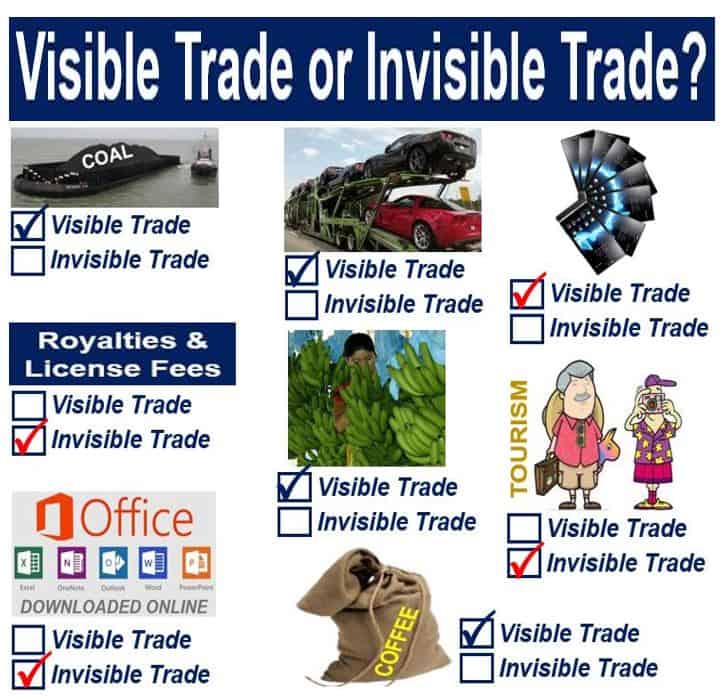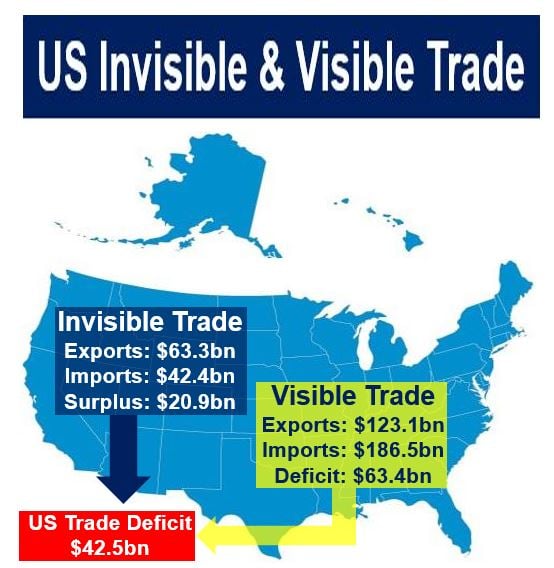Visible trade, in economics, is the importing and exporting of physical goods, products that you can touch. The product being traded could be a raw material such as coal, oil or wood, or the finished product, such as a car or smartphone. Visible trade refers to the exchange of physical goods in every stage of production. They are also known as international merchandise transactions.
Historically, the expansion of visible trade has been a cornerstone of economic development, with the Age of Exploration significantly broadening the scope and scale of international trade.
Visible trade contrasts with invisible trade, which involves trading internationally with intangible or abstract items – things you cannot touch, usually referred to as services.
A nation’s current account balance is the total exports of visible and invisible products, minus all visible plus invisible imports. If an economy exports more than it imports it has a trade surplus. A trade deficit occurs when imports are greater than exports.

Visible trade balance
The visible trade balance or visible balance is calculated by adding up all tangible goods exports minus all tangible goods imports.
-
Visible trade deficit
Many countries, such as the United States and United Kingdom, have a visible trade deficit and an invisible trade surplus. They import more physical things than they export, but import fewer services (in dollar value) than they export.
The majority of countries in the world do not have a zero visible trade balance – they usually run either a deficit or surplus. This will be offset by the invisible trade balance, other income transfers, investments and monetary flows, which together make up the overall balance of payments.
Our planet, in aggregate, appears to have a negative visible trade balance with itself – imports of physical goods are greater than exports.

There could be a number of reasons for this, such as measuring imported goods on a cost, insurance and freight basis, while exports are measured on a free on board basis. There might also be statistical errors occurring when imported goods are more closely recorded than exports.
Japan’s visible trade
In countries that lack raw materials, like Japan, substances such as crude oil, coal, bauxite, iron ore, lead, tin, zinc and other minerals make up a large part of their visible imports. Their visible exports consist mainly of finished products, including cars, machine tools, electronic equipment, ships, textiles, processed foods, etc.
Japan’s visible trade is therefore made up of lots of raw materials coming in and finished products going out.
However, in emerging nations with huge quantities of at least one natural resource, it is the other way round. Venezuela, Saudi Arabia and Russia, for example, export huge quantities of oil and import lots of finished products. Their visible trade moves in the opposite direction of Japan’s.
Digital platforms have revolutionized visible trade by streamlining global supply chains and facilitating the online tracking of shipments and inventory.
Balance of payments vs balance of trade
A country’s balance of payments is a systematic record of every single economic transaction between the consumers of the home country and consumers in the rest of the world over a specific period, usually a year, quarter or month.
By every transaction we mean invisible and visible trade (exports and imports of goods and services), unrequited transfers, and capital movements. Unrequited transfers are one-way payments of money, expecting nothing in return, usually done by governments as foreign aid, debt forgiveness, and membership dues to a global organization.
The balance of payments of a country is therefore a complete picture of its international transactions.
Balance of trade, on the other hand, is the difference between an economy’s imports and exports of goods and services – visible trade and invisible trade – over a specified period. It is the largest component of a nation’s balance of payments.
The balance of trade is a statistical tool that helps economists understand how strong a country’s economy is in relation to other nations.
The balance of trade is also known as the international trade balance or simply the trade balance.
Compound phrases with “visible trade”
In the world of “visible trade,” there are many related compound phrases. Let’s have a look at some, understand their meanings, and see how they are used in a sentence:
2 Educational Videos
These two interesting video presentations, from our sister YouTube channel – Marketing Business Network, explain what ‘Visible Trade’ and ‘Trade’ are using simple, straightforward, and easy-to-understand language and examples.
-
What is Invisible Trade?
-
What is Trade?
